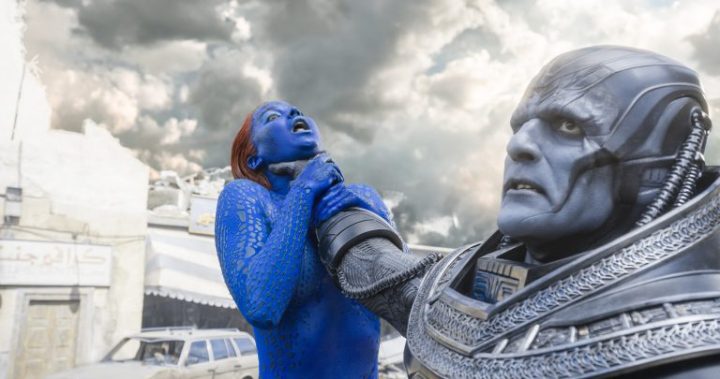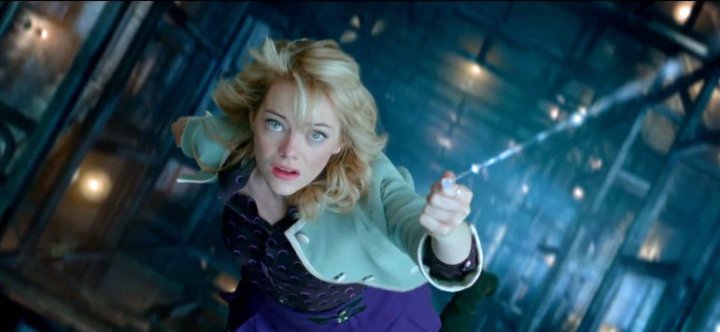The following was pitched to and commissioned by Flickering Myth
Henry Bevan on why female representation in superhero movies needs to evolve…

The X-Men: Apocalypse billboard featuring Oscar Issac’s Apocalypse choking Jennifer Lawrence’s Mystique has created a lot of negative noise. Actress/activist Rose McGowan called the billboard out for its “casual violence against women” and Fox has apologised for its tone-deafness. Flickering Myth’s Kirsty Capes articulately argues against McGowan’s points, but even if the awesome Mystique gives “as good as she gets”, Apocalypse‘s box office figures suggest the X-Men aren’t the most popular superhero property and the casual viewer will not understand the advert’s context or how it is playing with iconography — all they will see is Ivan Ooze strangling ginger Smurfette, a man victimising a woman.
The situation raises important questions about how female characters are represented in superhero cinema. Women are frequently storytelling props and are victimised to further the male character’s story and provide him with some motivation. The two most prominent tropes are the Damsel-in-Distress (DiD) and its more troubling cousin, the Women-in-Refrigerator (WiR).
This was coined by comic-book writer Gail Simone after Alexandra DeWitt was killed and shoved into a fridge to motivate Kyle Rayner/Green Lantern. DiWitt’s treatment is indicative of how women are commodities not characters in superhero media. The definition of WiR is simple: a female character is killed, injured or sexually assaulted to give the male hero motivation.

WiR is so common you could probably name three instances right now (Rachel Dawes, Elektra, Magneto’s wife and child in Apocalypse). The seemingly nonchalant attitude towards killing or maiming female characters objectifies women and furthers patriarchal ideas. The women in the stories support the men. For every Mystique and Wonder Woman, there are two female supporting characters who are just plot points. Their deaths are not statements on female violence like some might argue, as the WiR trope is all about the man.
Now, the trope has been subtly subverted. The first significant death of a superhero girlfriend doesn’t play by WiR’s rules. Gwen Stacy’s legendary death gives Peter Parker/Spider-Man the vengeful motivation to defeat the Green Goblin. However, a major element of Gwen’s death is that Peter is partly responsible. His webbing breaks her neck. Her death had a significant impact on the character as years later he catches Mary Jane in a similar situation but uses multiple webs. Peter learnt from Gwen’s death, differing it from the normal WiR incident as most male characters move on.
However, comparing Gwen’s comic and movie deaths will leave you disappointed. In The Amazing Spider-Man 2, Gwen (Emma Stone) dies because Peter (Andrew Garfield) isn’t fast enough to save her, not because his webbing kills her. This is a big difference. Whilst Gwen’s characterisation is one of the successes of the TASM series, she is actually punished for being an independent character. She states multiple times putting herself in danger is her choice and the repetition pins her death on her, absolving Peter’s guilt. Watching the film’s bonus features reveals many of the films faults arise from the filmmakers’ decision to adapt Gwen’s death. It’s just a shame they sacrificed the comics most powerful element.

In the comics, some victims of WiR grow from the experience. After Barbara Gordon is paralysed by the Joker she becomes the awesome Oracle she moves beyond her trauma and isn’t hindered by her disability. She grew from her ordeal, but many don’t. In the film world, most definitely don’t.
Two 2016 superhero movies have introduced female characters just to kill them off. The aforementioned Magneto’s wife and daughter in X-Men: Apocalypse and Maria Stark (Hope Davis) in Captain America: Civil War. Tony (Robert Downey Jr) snaps not when Howard (John Slattery) dies, but when his mother is killed. She is the emotional pressure point Zemo (Daniel Brühl) uses and she is a plot device. It’s a bizarre choice as she is introduced in THIS film and Tony’s daddy issues are well-established. It would have made more sense for Howard’s death to be the final straw but, no, they decided to kill his mother to make him snap.
WiR is in other media – Sansa’s rape in Game of Thrones was framed as forwarding Theon’s story – but superheroes dominate the multiplexes and incoming spandex tsunami makes it vital these films evolve. Female characters have been dying on-screen to motivate superheroes since 1978 with Lois Lane dying to get Superman to turn back time. The rumour suggesting that Brie Larson, who has spoken out against female violence, is circling Captain Marvel (who has been raped in the past) is promising. WiR is dated. It’s time to move on.

